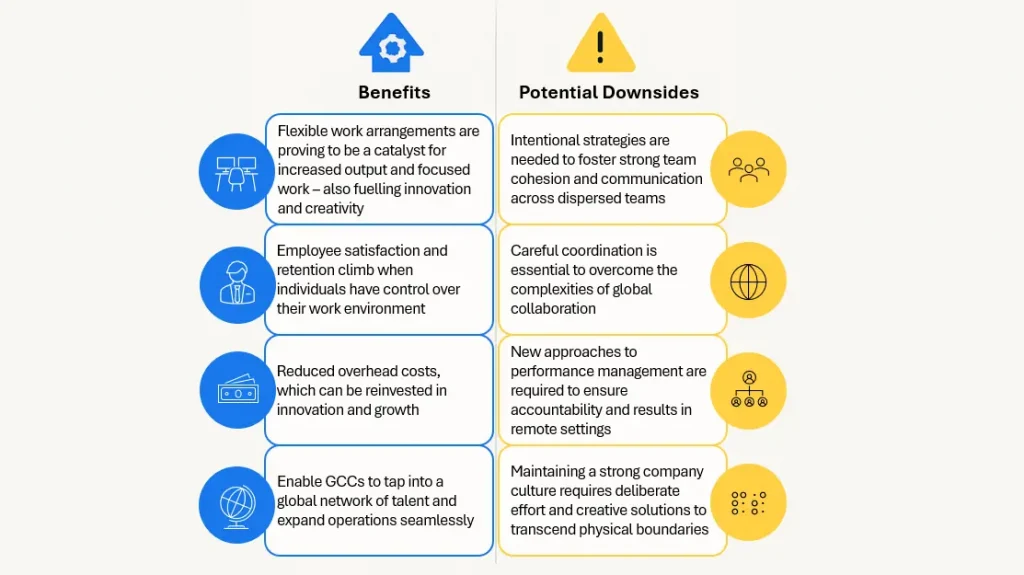Hybrid Models in GCCs: The New Standard
Published on
The rise of the hybrid operating model isn’t just a trend for Global Capability Centers (GCCs). It’s a fundamental shift in how they’re building for the future. As the world redefines work, GCCs are at the forefront, recognizing that agility and access to talent are paramount. This isn’t just about remote work. Instead, it is about strategically architecting a work environment that unlocks unprecedented productivity and collaboration.
Defining the Hybrid GCC Model
The hybrid operating model isn’t just a compromise between remote and in-office work. It recognizes a simple truth: employees thrive when empowered with flexibility. This approach, blending on-site collaboration with the autonomy of remote work is rapidly becoming the defining characteristic of the future of work, offering a compelling blend of benefits for both individuals and businesses.
As GCCs increasingly embrace this evolution, it’s critical to understand the full spectrum of possibilities and pitfalls.

Designing a Hybrid GCC Strategy
The hybrid work era demands a transformation in how GCCs operate. To truly thrive, the focus needs to shift towards:
- Strategic Technology Investment: Ensuring seamless communication and collaboration through secure and intuitive digital tools.
- Leadership Development: Equipping leaders with the skills to effectively manage and motivate remote teams, fostering a culture of connection and high performance.
- Cultivating Trust and Autonomy: Empowering employees with flexible schedules and clearly defined expectations, fostering a sense of ownership and accountability.
Role-Based Work Models
Customising work based on the nature and requirements of each role is a great approach to follow. Here are the various types of work models that GCCs adopt:
- Fully Remote: Roles that can be performed entirely from any location
- On-site: Roles requiring physical presence for operational or security reasons
- Hybrid: A mix of remote and on-site work tailored to role demands
Infrastructure & Tech Enablement
For hybrid GCCs to succeed, having the right technology and infrastructure is key. Here is how companies can leverage technology:
- Equip employees with enterprise-grade hardware and stable connectivity by providing high-performance laptops and reimbursing high-speed broadband to support seamless hybrid work.
- Use project management platforms like Jira, Asana, or Monday.com to assign tasks, track progress, and align distributed teams on shared goals.
- Facilitate real-time collaboration through communication suites like Microsoft Teams, Slack, or Google Workspace, which unify chat, video, and document sharing.
- Track productivity and optimize workflows using tools like Toggl Track, Clockify, or Harvest, paired with analytics dashboards from Power BI or Tableau for performance insights.
- Ensure secure, anytime access to files and systems by leveraging cloud storage solutions such as Google Drive, OneDrive, or enterprise platforms like AWS and Azure.
Real Estate Optimisation
Here are some key strategies for real estate optimisation when choosing the hybrid operating model:
- Leveraging employee-data to track space usage and design flexible seating spaces that can be scaled up or down according to requirement
- Downsizing office space to reduce operational costs if most employees are working remotely
- Redesigning workspaces to ensure the hybrid model works smoothly – including more collaboration/breakout rooms that are equipped with tools for video calling and collaboration between dispersed teams
- Prioritising meeting rooms, breakout areas, and innovation hubs
Employee Experience & Wellbeing
GCCs need to take active steps to support mental health, such as:
- Holding regular wellness check-ins by managers and HR teams
- Hosting virtual social events and team-building activities to maintain a sense of connection
- Providing Employee Assistance Programmes (EAPs) with counselling and mental health support
Governance & Performance Visibility
Effective governance and performance visibility are essential for ensuring that GCCs operate smoothly. Here are some strategies:
- Defining roles, responsibilities, and escalation paths clearly
- Promoting a culture of accountability and continuous improvement
- Using tools for real-time performance tracking
- Creating structured reporting and review mechanisms
- Ensuring transparency across all levels
Legal & Compliance Considerations
Since GCCs often handle sensitive and proprietary information, strengthening cybersecurity is essential to protect against potential breaches. Key measures typically include:
- Enforcing multi-factor authentication (MFA) for remote system access
- Using advanced encryption for data transmission
- Conducting regular security audits to stay compliant with regulations such as GDPR, HIPAA, and PCI DSS
Leadership & Culture Building
Strong leadership and a well-defined culture are vital to the long-term success of GCCs. Key focus areas include:
- Managing the team with empathy and transparency
- Encouraging open communication and continuous feedback
- Supporting career growth, learning, and recognition
- Promoting inclusivity and collaboration across all levels and locations
Case Study
A retail platform in Latin America is a great example of a global captive center leveraging a hybrid operating model to boost its technology capabilities. The first Chilean conglomerate to establish a GCC in India, it has been able to employ top talent with expertise in e-commerce and engineering thanks to its workplace strategy and partnership with leading technology consultants.
By adopting a hybrid approach, GCCs are creating more resilient, agile, and scalable operations that support global business needs. With its proven track record, ANSR is enabling companies to successfully design, build and operate future-ready GCCs powered by effective hybrid operating models.
Contact us to know more.




